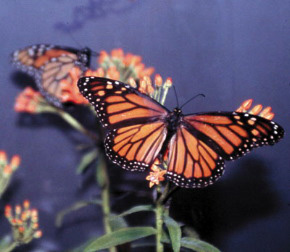 |
 |
 |
 Editorials | Environmental | September 2007 Editorials | Environmental | September 2007  
Enjoy the Migration of Monarch Butterflies
 Melody Bell Wilkes - Salisbury Post Melody Bell Wilkes - Salisbury Post
go to original


| | A monarch butterfly rests on a milkweed. |
The monarch is perhaps the best-known American butterfly and September is the best time to see them.

With their large orange and black wings, monarchs are a familiar site in a range of habitats. They frequent open fields, pastures, marshes and roadsides.

As beautiful as monarchs are, they are unpleasant to would-be-predators. Milkweed plants, upon which the monarch caterpillars feed, contain toxic chemicals called cardiac glycosides. These toxins accumulate and remain in the bodies of the pupae and adults, which makes them highly distasteful. Once a bird takes its first nibble on a delicious looking monarch, it learns a valuable lesson not to do it again. That's why other butterflies try to mimic its color and patterns.

Monarchs are found throughout most of the United States and Canada. With the arrival of fall, it's time for them to vacate their breeding grounds and fly south where winter temperatures are mild. A certain mountain refuge in central Mexico's Michoacan state (about 100 miles west of Mexico City) is where the grandchildren and great- grandchildren of butterflies that made the same trip the previous year travel. Without any landmarks to guide them, they make this journey over thousands of miles solely by instinct. Scientists believe the butterflies are guided by celestial navigation and magnetic fields.

During migration, they fly high above the ground, pausing occasionally to take nectar from fall-blooming flowers.

By mid-November, the majority have arrived and the colony may number more than 100 million butterflies in an area 10 to 20 acres in size. It is estimated that more than a dozen colonies form each winter in this one remote region.

From November to mid-March, the butterflies cling to trees living off of stored fat with an occasional visit to a moist stream bank for water. They can survive several months without food since the cooler temperature in the mountains causes the butterfly's metabolic rate to drop.

By mid-March, butterflies know it is time to move north. They mate at their mountain site and fly to the southern part of the United States, lay their eggs and die. In April or May, the offspring have hatched and fly farther north to central United States where they lay their eggs and die.

The next generation finally reaches the northernmost states and their own breeding grounds. By mid-August, adults turn south for the journey back to central Mexico, and the life cycle continues.

September is the height of the Monarch migration. If by chance you see a traveling monarch, reflect on the journey it has ahead.

You can help by planting milkweed plants, which the monarchs lay their eggs on. You can find them at garden centers.

Melody Wilkes is owner of A Walk in the Woods, an environmental education company that provides outreach wildlife programs. Contact her at 704-436-9048 or visit www.awalkinthewoods.us. | 
 | |
 |



